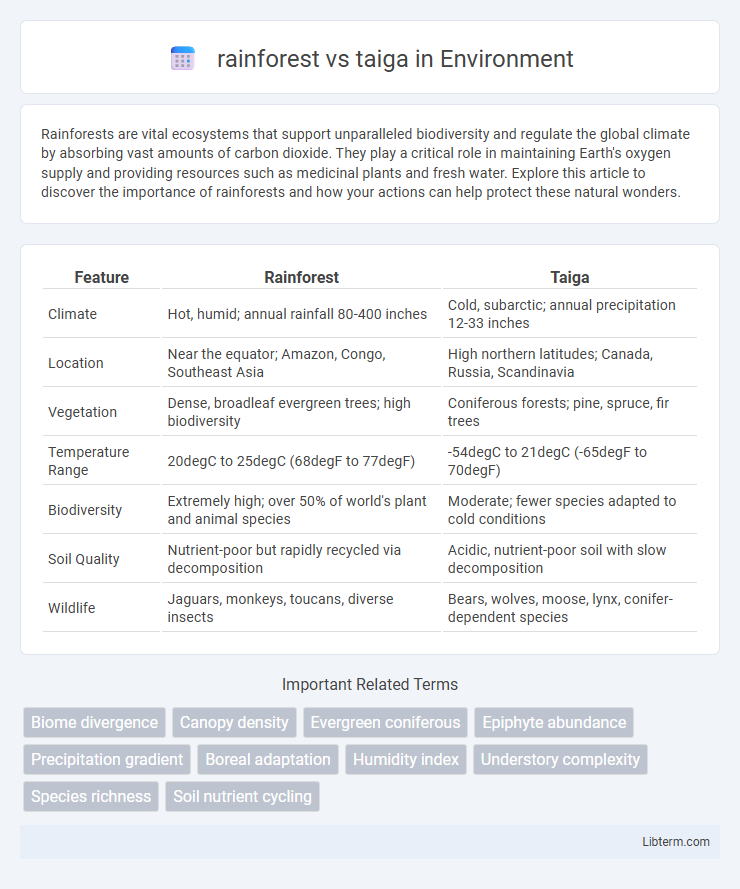Rainforests are vital ecosystems that support unparalleled biodiversity and regulate the global climate by absorbing vast amounts of carbon dioxide. They play a critical role in maintaining Earth's oxygen supply and providing resources such as medicinal plants and fresh water. Explore this article to discover the importance of rainforests and how your actions can help protect these natural wonders.
Table of Comparison
| Feature | Rainforest | Taiga |
|---|---|---|
| Climate | Hot, humid; annual rainfall 80-400 inches | Cold, subarctic; annual precipitation 12-33 inches |
| Location | Near the equator; Amazon, Congo, Southeast Asia | High northern latitudes; Canada, Russia, Scandinavia |
| Vegetation | Dense, broadleaf evergreen trees; high biodiversity | Coniferous forests; pine, spruce, fir trees |
| Temperature Range | 20degC to 25degC (68degF to 77degF) | -54degC to 21degC (-65degF to 70degF) |
| Biodiversity | Extremely high; over 50% of world's plant and animal species | Moderate; fewer species adapted to cold conditions |
| Soil Quality | Nutrient-poor but rapidly recycled via decomposition | Acidic, nutrient-poor soil with slow decomposition |
| Wildlife | Jaguars, monkeys, toucans, diverse insects | Bears, wolves, moose, lynx, conifer-dependent species |
Introduction: Rainforest vs Taiga
Rainforests and taigas are two distinct biomes characterized by unique climates and biodiversity. Rainforests, primarily found near the equator, exhibit high temperatures and immense annual rainfall, supporting diverse ecosystems with dense vegetation and rich species variety. Taigas, or boreal forests, located in northern latitudes, experience long, cold winters and moderate precipitation, dominated by coniferous trees adapted to harsh climatic conditions.
Geographic Distribution
Rainforests predominantly cover regions near the equator, including the Amazon Basin in South America, Central Africa, and Southeast Asia, thriving in warm, humid climates with abundant rainfall. In contrast, taiga forests, also known as boreal forests, stretch across the high northern latitudes of North America, Europe, and Asia, particularly Canada, Russia, and Scandinavia, characterized by cold temperatures and long winters. The geographic distribution of these biomes reflects their adaptation to distinct climatic conditions, influencing their biodiversity and ecosystem functions.
Climate Differences
Rainforests experience a warm, humid climate with high annual rainfall exceeding 2000 mm, creating a stable environment for diverse ecosystems. Taigas, or boreal forests, endure long, cold winters and short, mild summers with annual precipitation between 300 and 900 mm, primarily as snow. These distinct climatic conditions result in different vegetation adaptations and biodiversity levels.
Biodiversity Comparison
Rainforests exhibit extraordinarily high biodiversity, housing more than half of the world's plant and animal species due to their warm, humid climate and complex ecosystem layers. Taiga, or boreal forests, contain fewer species, dominated by cold-tolerant conifers, with biodiversity adapted to harsh winters and short growing seasons. The immense species richness in rainforests contrasts sharply with the taiga's specialized but less diverse flora and fauna.
Soil Composition and Fertility
Rainforest soils are typically nutrient-poor and acidic due to heavy rainfall leaching away minerals, but their rapid decomposition of organic matter creates a thin, nutrient-rich top layer supporting lush vegetation. In contrast, taiga soils, known as podzols, are acidic and low in fertility, characterized by slow organic matter decomposition caused by cold temperatures, resulting in a thick layer of partially decomposed organic material. The fertility disparity is significant: rainforests sustain high biodiversity despite poor soils through efficient nutrient cycling, while taigas have limited plant diversity due to nutrient constraints in the soil.
Plant Adaptations
Rainforest plants exhibit broad leaves with drip tips to shed excess water efficiently, while taiga vegetation features needle-like leaves coated with wax to reduce water loss and withstand freezing temperatures. Epiphytes and lianas dominate rainforests by growing on other plants to access sunlight, contrasting with the taiga's coniferous trees adapted to nutrient-poor, acidic soils. These adaptations reflect specialized strategies for surviving high humidity and heavy rainfall in rainforests versus the cold, dry conditions of the taiga.
Animal Life and Survival Strategies
Rainforests host an immense diversity of animal species, including jaguars, tree frogs, and toucans, which rely on dense foliage for camouflage and a complex food web for survival. Taiga animals like lynxes, moose, and Siberian tigers adapt to extreme cold by developing thick fur, hibernating, or migrating to conserve energy during long winters. Both biomes showcase specialized survival strategies shaped by their distinct climates, with rainforests emphasizing biodiversity and resource competition, and taigas focusing on temperature resilience and seasonal adaptation.
Impact of Human Activities
Human activities in rainforests, such as logging, agriculture, and mining, accelerate deforestation and biodiversity loss, leading to significant disruptions in carbon storage and climate regulation. In contrast, taiga regions face challenges from logging, mining, and fossil fuel extraction, which degrade habitats and contribute to greenhouse gas emissions. Both ecosystems suffer from habitat fragmentation and altered water cycles, emphasizing the urgent need for sustainable management and conservation strategies.
Environmental Importance
Rainforests, hosting over half of the world's terrestrial species, play a crucial role in carbon sequestration and oxygen production, significantly mitigating climate change. Taiga forests, the largest terrestrial biome, store vast amounts of carbon in their dense coniferous trees and soil, helping regulate global temperatures and water cycles. Both ecosystems support biodiversity, influence atmospheric conditions, and sustain vital natural resources essential for maintaining Earth's environmental balance.
Conservation Challenges and Efforts
Rainforests face deforestation due to logging, agriculture, and mining, threatening biodiversity and carbon storage, prompting conservation efforts like protected reserves and sustainable farming initiatives. Taigas encounter challenges from climate change-induced permafrost thaw and wildfires, leading to habitat loss and increased greenhouse gas emissions, with conservation focusing on fire management and monitoring ecosystem health. Both biomes require international cooperation and support for indigenous communities to enhance conservation effectiveness and resilience.
rainforest Infographic

 libterm.com
libterm.com